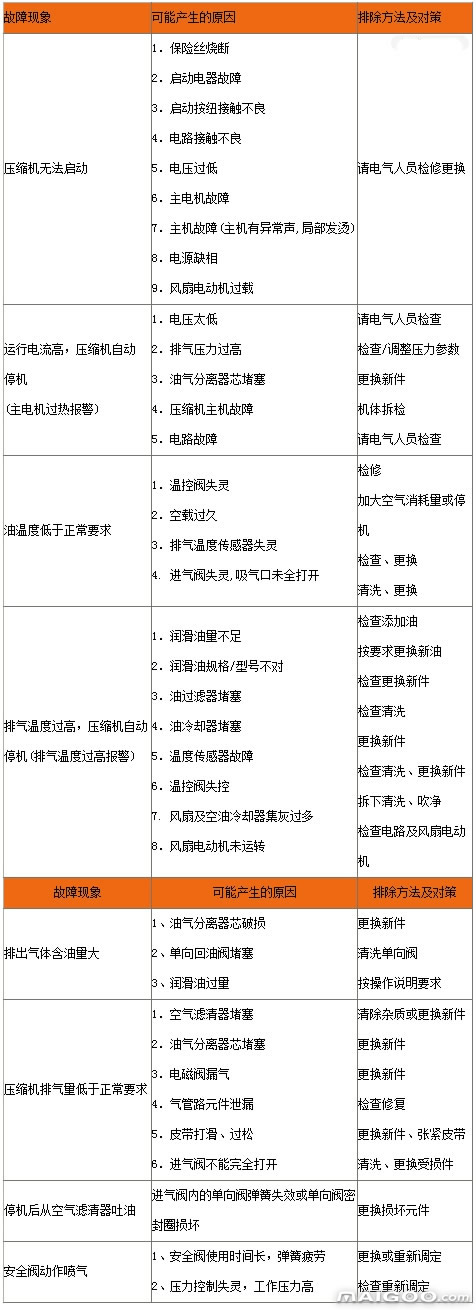Maintenance and treatment of common fault air compressor in air compressor maintenance
One, the troubleshooting of air compressor
Common failures of air compressor

1, Symptom: Unit exhaust temperature is high (more than 100 ℃)
Unit coolant level is too low (should be seen from the oil speculum, but not more than half);
Oil cooler dirty; Oil filter plugged; Thermostatic valve defective (bad component); Oil shut-off solenoid valve without electricity or coil damage; Oil break solenoid valve diaphragm ruptured or aged; Fan motor failure; Cooling fan damaged; Poor air duct or exhaust resistance (back pressure); Ambient temperature outside the specified range (38 ° C or 46 ° C); Temperature sensor fault (Intellisys control unit); Malfunction of the pressure gauge (relay control unit).
2, the fault phenomenon: large unit fuel consumption or compressed air oil content
Coolant amount too much, the correct position should be observed when the unit load, when the oil level should not be higher than half; back to the oil pipe plugging; back to the oil pipe installation (with the oil separation from the bottom of the core) does not meet the requirements; Gas pressure is too low; Oil separation core rupture; Separation of internal partition wall separation damage; Unit has oil spills; The deterioration of the coolant or extended use.
3, Symptom: Unit pressure is low
The actual gas consumption is greater than the unit output gas volume; purge valve failure (loading can not be closed); intake valve failure; hydraulic cylinder failure; load solenoid valve (1SV) failure minimum pressure valve stuck; user pipe network leaks; Low; pressure sensor failure (Intellisys control unit); pressure gauge failure (relay control unit); pressure switch failure (relay control unit); pressure sensor or pressure gauge input hose leaks;
4, Symptom: Unit exhaust pressure is too high
Pressure sensor failure (Intellisys control unit); Pressure gauge failure (relay control unit); Pressure switch failure (relay control unit)
Second, air compressor fault diagnosis and troubleshooting
(1) air compressor oil leakage, pay attention to observe the oil seal parts, check whether there is cracked oil seal, lip crack or flange. Have one of the above conditions should be replaced; Check the oil seal and spindle with scratches and defects, there is scratches and defects should be replaced. Check the return oil is smooth, poor return to the crankcase pressure is too high lead to oil spill or fall off, you must ensure that the minimum diameter of the return pipe, and not distorted, not bending, smooth back to the oil. Check the oil seal, with the size of the box, do not meet the standards to be replaced.
(2) Forcibly move the spindle to check whether the neck gap is too large, the gap is too large should be replaced at the same time bearing and oil seal.
(3) Check the seals at the joints and repair or replace the gaskets. Check the screws of the inlet and outlet fittings and the threads of the tank and tighten.
(4) air compressor leaks and re-adjust the tightness of the belt, thumb press 10 mm is appropriate.
(5) air compressor oil leaks, you need to check the casting box or processing the existence of defects, repair or replacement of defective parts.
Overheating Failure Analysis
In the daily operation of the air compressor, the air compressor will overheat due to the overloaded operation of the air compressor for a long time.
Compressor overheating Fault phenomenon:
(1) air compressor exhaust temperature is too high.
(2) running parts hot.
Third, the causes of cracks in the air compressor parts analysis and maintenance methods
Air compressor parts cracks common causes are:
(1) cooling water in the body cylinder head, not in a timely manner after the winter parking water and freeze;
(2) Due to the internal stress generated during the casting casting, in the use of vibration gradually expanded significantly;
(3) due to mechanical accidents caused, such as the piston rupture, connecting rod bolts broken, resulting in broken connecting rod off, or balance of iron on the crankshaft fly out of the broken body or gas cutting parts off the top bad cylinder head.
For cracks after the inspection and maintenance methods are:
(1) infiltration of kerosene law: The inspection process is first with a cotton yarn soaked in kerosene wipe the body, cylinder head, and then use a dry cotton yarn Jiang kerosene to wipe where cracks may occur, and immediately in these places map white powder, this time In cracked areas, kerosene will penetrate the white powder, the crack site and the length of the show clearly.
(2) water pressure method: water pressure method is to improve the cooling water pressure to check the crack site. Hydraulic inspection is carried out on a special equipment hydraulic tester. In the equipment of poor environmental conditions of enterprises, some with ordinary hand pump restructuring of simple equipment can also be checked. The first body or cylinder head pipe joints try to block, only one of the hose joints with the pump outlet connected to the pump, the body plane should use a size appropriate special cover, the cooling water can not spill. Then open the switch pressure pump, room water into the cooling water jacket. To be switched off after the water switch off, continue to press the pump, the pressure gauge pointer reaches 3-4 atmospheres when the water supply to stop. At this point, by looking at the body, the cylinder head inside and outside the presence of leakage or seepage phenomenon, you can determine the existence of cracks.
